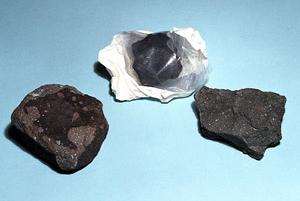Carbonaceous chondrite

Carbonaceous chondrites or C chondrites are a class of chondritic meteorites comprising at least 7 known groups and many ungrouped meteorites. They include some of the most primitive known meteorites. C chondrites represent only a small proportion (~5%) of meteorite falls.
Carbonaceous chondrites are grouped according to distinctive compositions thought to reflect the type of parent body from which they originated. These are named after a prominent meteorite—often the first to be discovered—in the group.
Several groups of carbonaceous chondrites, notably the CM and CI groups, contain high percentages (3% to 22%) of water,[1] as well as organic compounds. They are composed mainly of silicates, oxides and sulfides, while the minerals olivine and serpentine are characteristic. The presence of volatile organic chemicals and water indicates that they have not undergone significant heating (>200°C) since they formed, and their compositions are considered to be close to that of the solar nebula from which the solar system condensed. Other groups of C chondrites, e.g. CO, CV, and CK chondrites, are relatively poor in volatile compounds, and some of these have experienced significant heating on their parent asteroids.
Some famous carbonaceous chondrites are: Allende, Murchison, Orgueil, Ivuna, Murray, and Tagish Lake.
CI group
This group, named after the Ivuna meteorite, have chemical compositions that are close to that measured in the solar photosphere, neglecting gaseous elements. In this sense, they are chemically the most primitive known meteorites. They typically contain a high proportion of water (up to 22%),[1] and organic matter in the form of amino acids[2] and PAHs.[3] Aqueous alteration promotes a composition of hydrous phyllosilicates, magnetite, and olivine crystals occurring in a black matrix, and a possible lack of chondrules. It is thought they have not been heated above 50 °C (122 °F), indicating that they condensed in the cooler outer portion of the solar nebula.
Five CI chondrites have been observed to fall: Ivuna, Orgueil, Alais, Tonk and Revelstoke. Several others have been found by Japanese field parties in Antarctica. In general, the extreme fragility of CI chondrites causes them to be highly susceptible to terrestrial weathering, and they do not survive on Earth's surface for long after they fall.
Organic matter
Ehrenfreund et al. (2001)[2] found that amino acids in Ivuna and Orgueil were present at much lower concentrations than in CM chondrites (~30%), and that they had a distinct composition high in β-alanine, glycine, γ-ABA, and β-ABA but low in AIB and isovaline. This implies that they had formed by a different synthetic pathway, and on a different parent body from the CM chondrites. Most of the organic carbon in CI and CM carbonaceous chondrites is an insoluble complex material. That is similar to the description for kerogen. A kerogen-like material is also in the ALH84001 Martian meteorite (an achondrite).
The CM meteorite from Murchison, Victoria has over 70 extraterrestrial amino acids and other compounds including carboxylic acids, hydroxy carboxylic acids, sulphonic and phosphonic acids, aliphatic, aromatic and polar hydrocarbons, fullerenes, heterocycles, carbonyl compounds, alcohols, amines and amides.
References
- ^ a b Norton, O. Richard (2002). The Cambridge Encyclopedia of Meteorites. Cambridge: Cambridge University Press. pp. 121–124. ISBN 0-521-62143-7.
- ^ a b Ehrenfreund, Pascale (2001). "Extraterrestrial amino acids in Orgueil and Ivuna: Tracing the parent body of CI type carbonaceous chondrites". Proceedings of the National Academy of Sciences. 98 (5): 2138–2141. doi:10.1073/pnas.051502898.
{{cite journal}}: Unknown parameter|coauthors=ignored (|author=suggested) (help) - ^ Wing, Michael R. (1992). "The origin of the polycyclic aromatic hydrocarbons in meteorites". Origins of Life and Evolution of the Biosphere. 21: 375–383.
{{cite journal}}: Unknown parameter|coauthors=ignored (|author=suggested) (help)
- Carbonaceous chondrites at The Encyclopedia of Astrobiology, Astronomy, and Spaceflight
- Gilmour, I. (1997). Bletchley: The Open University. ISBN 0749281820.
{{cite book}}: Missing or empty|title=(help); Unknown parameter|coauthors=ignored (|author=suggested) (help)
